Unpredictable Transformations: The Evolution of Feral Rabbits in New Environments
In an intriguing dive into the ever-changing world of feral animals, Associate Professor Emma Sherratt from the University of Adelaide, along with an international team of researchers, embarked on a mission to unveil the mysteries behind feral rabbits’ characteristics. This study, which casts a spotlight on 912 wild, feral, and domestic rabbits, sheds light on the intriguing transformations these creatures undergo in newly adopted habitats.
The Concept of Feralisation
Feralisation, as explained by Associate Professor Sherratt, represents the fascinating process wherein domestic animals adapt to their environment independently, without human aid. Through this lens, feral rabbits become an interesting case study. Contrary to common expectations that these rabbits would revert to ‘wild’ forms, the findings present a much more complex picture. According to Technology Networks, feral rabbits exhibit a mix of traits seen in both wild and domestic populations, with some traits standing entirely separate from either category.
Body Size and Skull Shape Variations
A surprising revelation of the study is the diverse body size and skull shape witnessed among feral rabbit populations. In some regions, particularly in places like Australia and New Zealand where predators are scarce, variations tend to be more pronounced. The larger body size of Australian feral rabbits compared to their European counterparts is now under the research spotlight.
Evolutionary Pressures and Trait Plasticity
The evolutionary pressures, or lack thereof, seem to significantly impact the development of feral rabbits. Where evolutionary pressures are relaxed, such as predator-free zones, rabbits potentially demonstrate a more extensive range of physical traits—’trait plasticity,’ as put by Associate Professor Sherratt. These variations in traits could help feral rabbits to better adapt and survive in their respective environments.
The Future of Feral Rabbit Research
With these findings paving the way for further exploration, Associate Professor Sherratt and her team are set to delve deeper into the environmental factors influencing these adaptations. By focusing on skull shape, a valuable indicator of animal-environment interaction, this study aims to unlock more insights into the evolution of feral rabbits as they bridge the gap between domesticity and the wild.
Understanding the shifts that feral rabbits undergo when they invade new habitats is not just a scientific curiosity—it is key in predicting the environmental effects of other invasive species. This knowledge could inform strategies for mitigating their impact on local ecosystems.
The study’s implications transcend the immediate subject, offering a framework for understanding the adaptive journeys of various feral species around the globe.




